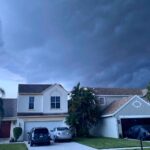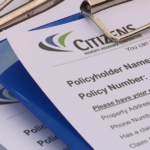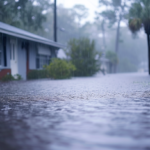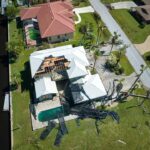You are getting ready to purchase a home, and you hear someone mention Homeowners Insurance… Dun, dun, duuuuuuuuuuunnnnnnn! For many first time buyers, shopping for the best insurance coverage can be a downright scary task. Not only are you worried about finding the dream home that meets your budget, but now you have to think about things like premiums, flood zones, and liability coverage for it too.
Here are a few things you should consider before you commit and sign any dotted lines:Contact different companies or go through an agent that can find you coverage comparisons. Your mortgage lender can, and probably will, require you to have homeowners insurance. You may be required to purchase additional insurance – like flood insurance, for example. Be sure to compare coverage, price and customer reviews. Make sure to speak with someone who can help you get the right type and amount of coverage to meet your needs. Insurance is like a snowflake – it is as individual as each person who is in need of coverage. REMEMBER: Shop for value, not necessarily rock-bottom price. Since you’ll mainly deal with insurance companies during times of disaster, make sure the company you choose has great customer service and superior reviews.
This isn’t something everyone thinks about, but it is also an important decision along the process. Escrow your insurance payments with your mortgage payments. If you’re like most homeowners, you’ll tack monthly insurance payments onto your mortgage check. Your lender will pay your insurance premiums (usually your property taxes, too) out of your escrow account. Lenders prefer this option because it lets them know your insurance premiums are being paid, and their investment is well protected. Before closing, be sure to check with the lender about whether or not you will need to pay the first year of the homeowner’s policy. Some lenders require you to pay for one year of insurance at closing. They will want you to bring information about the insurance policy you have chosen and the money to cover the first year’s premium at that time.
Make sure you’re getting adequate coverage. The most important part of homeowners insurance is the level of coverage you choose. Avoid paying for more than you need, but don’t try to be so thrifty that if you need to use your coverage, it doesn’t replace your home. Some people can handle a higher deductible for lower premiums while others may prefer a higher premium for a smaller deductible should a disaster strike. Like I said, it is a completely individual experience; here are the most common levels of coverage and a brief explanation on what they are:
HO-2 – Broad policy that protects against 16 perils that are named in the policy.
HO-3 – Broader policy that protects against all perils except those specifically excluded by the policy.
HO-5 – Premium policy that typically protects newer, well-maintained homes; it covers against all perils except those specifically excluded by the policy.
HO-6 – Insurance for co-ops/condominiums, which includes personal property coverage, liability coverage and coverage of improvements to the owner’s unit. Insurance for the actual structure usually comes through the association.
HO-7 – Similar to an HO-3 policy, but for mobile homes.
HO-8 – Policy specifically for older homes, with similar coverage to an HO-2 policy. However, it only covers actual cash value.
When you are shopping around for your policy, and trying to make heads or tails of all of the terminology, it can help to speak to an agent that can help decode all the jargon and also help you identify your individual needs.
Also, it isn’t enough to just pick the right policy. You also need to understand the details of your policy. Before you make a decision, understand these homeowners insurance terms:
Deductible – This refers to the amount you must pay out of pocket before your insurance kicks in; the higher the deductible, the lower the annual premium.
Liability Coverage – This is coverage that will pay medical or legal bills if someone is hurt on your property, usually due to negligence.
Personal Property – Sometimes called the contents of you home, this is tangible property such as furniture, electronics and clothing.
Premium – This is the price you pay for insurance, usually annually or monthly.
Replacement Cost – This is the kind of insurance that pays the full cost of replacing your dwelling or personal property, up to a maximum dollar amount. Most standard policies offer replacement cost, but you want to be sure the maximum amount is high enough.
Actual Cash Value – This type of policy gives you the current cash value (with depreciation) for personal property or your dwelling. It’s possible to have actual cash value dwelling coverage (as with an HO-8 policy), but to get replacement cost coverage for your contents.
Sub-Limits – Homeowners insurance policies will include limits, but they’ll typically also have sub-limits. For instance, the sub-limit on personal property for a $500,000 policy would typically be $250,000, or 50 percent of dwelling coverage.
Riders – These are policies you can include on your overall insurance policy to cover specific items. For instance, expensive antiques, jewelry, and artworks are often covered under their own rider because they’re too valuable to be covered as regular personal property. Some HO-8 policyholders also may get additional riders for things like heating, ventilation and air-conditioning systems, which are part of the home and expensive to replace.
Finally, there is one thing that you should always do before committing to anything with a high ticket value. You should shop/lookout/ask for discounts. Some insurance companies will provide discounts for having multiple policies like auto and home. Additional discounts may come from making your home more disaster resistant. Adding storm shutters, reinforcing a roof or even retrofitting older homes to withstand major storms could land you a bit off your policy. Even adding a security system could save you a few bucks and add to your family’s safety.
The most important thing to do while shopping for homeowners insurance is to get educated and ask for help when you need it. Part of an agent’s job is to help you traverse through all the terminology and to listen to your needs. This will ensure that you will learn more about what you are paying money for, and how it will help you when you need it.









